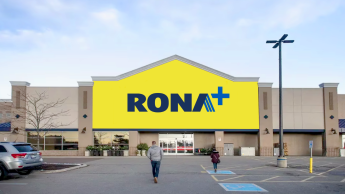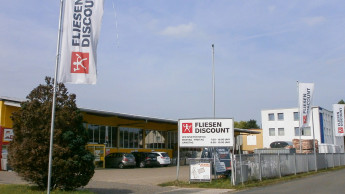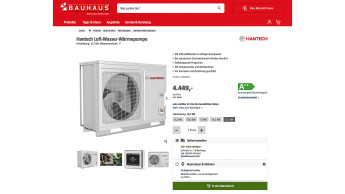
deep insights, facts & figures
16.04.2012
Four retailers divide up more than half of the Canadian home improvement market between them. Lowe’s has been thoroughly involved since 2007 as well
As the Gateway to North America, Canada’s home improvement market has shown its quiet strength though the economic downturn. After a decade of very strong growth, the Canadian home improvement dipped 1.5% in 2008 and 3.0% in 2009, holding steady at Cdn$39.8 billion in 2010. A very slight (under 1.0%) upswing is predicted in 2011, with slightly stronger results forecast for 2012. The results of the latest HARDLINES Business Conditions Survey indicates an upswing in sales by both retailers and vendors. Comparing 2011 to 2010 sales, over 40% of the Retailers indicated their sales were up, with 35% experiencing reduced sales and 24% unchanged. Vendor sales were similar with 42% up, 36% down and 21% unchanged. Significantly, 65.6% of the Retailers (versus 33.6% at the end of the 3rd Quarter), expect sales to increase over the next six months. Using sales and other statistics from the companies themselves in most cases, combined with competitive intelligence, much of it proprietary, from the Incredible Hardlines Database, Hardlines has tracked the growth of the retail home improvement industry in Canada since 1997, measuring the size of the market by sales at retail from all related retailers in the following channels: • hardware stores; • building centres and home centres; • big box home improvement stores; • related hardware, seasonal and home improvement sales by Canadian Tire stores; • estimated sales of hardware, home improvement and home décor products by mass merchants and club stores. Not included: sales by specialty installers, such as kitchen and bath stores, specialty flooring and tile stores; plus sales by plumbing and electrical wholesalers, including Rona’s Noble commercial division. Four retailers represented 53.7% of the Canadian home improvement marketplace in 2010: Rona, Home Depot, Home Hardware and Canadian Tire. Following are snapshots of the big four and their strengths – as well as an update on Lowe’s Canada, the newcomer to the big box market in Canada. Rona The largest home improvement retailer in Canada, Rona inc had a 15.8% share of the Canadian home improvement market in 2010. A national publicly traded wholesale distributor and retailer, with more than 900 bannered points of sale, including dealers served by TruServ Canada, and eight distribution centres across the country. Stores within Rona are both dealer- and corporately-owned, operating in a variety of formats ranging from hardware stores and specialty (garden and paint centres), to building and home centres, and big boxes. Rona’s four pronged expansion strategy has been increasing same-store sales, acquisitions of existing retail businesses, new dealer recruitment (affiliate stores), and expansion of existing dealers’ operations. Rona has long contended its mix of small, medium and large stores positions its dealers to serve different customer niches. In a period of economic downturn, the various formats offer more potential to protect income sources. When announcing year end results for 2011, Rona added that it is likely to close up to 20 of its big boxes, changing to a focus on “proximity” stores of approximately 35,000 ft2. This change is expected to begin in 2012. Rona’s post-recession strategy has included looking both internally and externally for refinements and improvements. The current phase of the “New World” growth initiative that began in 2008, Phase Three, includes continued increases of sales of its proprietary brands (which recently reached 27%, exceeding the 24% goal). Rona is carrying three private labels and eight controlled brands in 2011. These fall into two categories: “Rona” branded products and proprietary brands. Rona has positioned itself as an industry leader in eco-responsibility. It endows a chair in Life Cycle Assessment Methodology at the École Polytechnique de Montréal. Rona’s ECO products line includes a recycled paint program across Canada. Long a practice in Quebec, the program of not only selling recycled paint but of providing used paint recycling depots at its large stores has been spread into the rest of Canada. Another effort includes sourcing wood products from certified forests. A major change in the Canadian marketplace was Rona’s buyout of TruServ Canada in the 4th quarter of 2010. A dealer-owned co-operative corporation owned entirely by its dealer members, the hardware wholesaler is based in Winnipeg, Manitoba and has an LBM distribution centre for its Central and Eastern Canadian customers in Kitchener, Ontario. TruServ’s retail sales were an estimated $600 million in 2010. The company’s main banner True Value, was licensed from The True Value Company in the U.S. That contract has lapsed as of October 2011. In its place, Rona and TruServ have created a new banner: TRU, which was rolled out in the fall of 2011 with hardware stores. Lumberyards, farm stores and a Quebec brand, UNIQ, are all part of the 2012 expansion of the brand.Home Depot CanadaHome Depot Canada is second behind Rona in total sales in Canada, but by far the largest big box retailer with estimated 2010 sales of $5.2 billion. 2011 sales are expected to increase by 3%. A major change in Canada was the departure of long-time president, Annette Verschuren. She was replaced by Bill Lennie, former senior vice president of merchandising, international and sourcing from the Pacific Northwest division of Home Depot. Since assuming control, he has implemented executive and buyer changes. Home Depot Canada has historically been one of Home Depot’s most profitable enterprise divisions, operating in a big box environment less mature than that in the U.S. However, it has felt the impact of slowed consumer confidence and the weak economy with sales down more than 8% over the previous year. Stores range in size from 60,000 sq. ft to 115,000 sq. ft., with an additional 15,000 -25,000 sq. ft. devoted to the garden centre. Headquartered in Toronto, Ontario, it has four distribution centres across Canada. In April 2011, the retailer, with 180 stores in Canada, opened its first and only new outlet of 2011 in Chilliwack, BC. With the hold on further expansion, Lennie’s emphasis has been on customer service and changes to the supply chain which align Home Depot Canada more closely with the US model. More than ever, said Lennie in 2011, Home Depot Canada’s success rests squarely on customer service, which is “our top priority.” In 2010, notes Lennie, customer service improved in all five categories tracked by its “Voice of the Customer” survey. He attributes those gains in large measure to the 2009 introduction of Home Depot’s Customers FIRST service model, which “calls on associates to find every customer who enters our stores and help them find the products that meet their needs,” says Lennie. The company has rolled out a similar program for its contractor customers, called First for Pros. Another key to Home Depot Canada’s growth is improvements to its in-stock position. Frank Blake, chairman of the Atlanta based firm, stated in August that the company is “beginning the process of optimizing our supply chain in Canada,” meaning that more of its Canadian stores’ inventory will flow through Home Depot’s massive Rapid Deployment Centres. The 19 RDCs currently in operation handle 63% of the inventory shipped to the U.S. stores. Lennie says the “final piece” to his division’s “customer-focused strategy” is to ensure its stores are well merchandised and easy to shop. The formation of its 1,000-person Merchandising Execution Team to handle that task has resulted in “a tangible improvement” that “offers a consistent coast-to-coast approach to in-store merchandising service.” The retailer is also banking on Home Depot Canada’s website, which gets 45 million visits annually, to become a differentiator. By the end of the third quarter, Home Depot will complete its chain-wide rollout of its “Buy Online Pickup In-Store” program. Blake noted that 30% of his company’s website visitors who use its “check inventory” function make a purchase in the store within two days, and a significant number make an additional purchase on the day of the pickup.Home Hardware Stores The number three player in Canada, this dealer-owned co-operative wholesaler supplies paint, hardware, housewares and building supplies to a network of 1,100 stores, located mainly in small-town and rural Canada. Total sales in 2010 were $4.86 billion. The stores represent a variety of formats: 530 hardware stores (Home Hardware), 504 home centres and building centres (Home Hardware Building Centre and Home Building Centre), and 50 stand-alone furniture stores (Home Furniture) across Canada. The company keeps 63,000 SKUs stocked in four distribution centres across Canada. In 2010, co-founder Walter Hachborn retired and turned over the management of the company to his president and COO, Paul Straus, currently President and CEO. Home Hardware’s Building Centre format has generated some of the group’s greatest growth. Dealers take advantage of this opportunity to expand into the fast-growing kitchen and garden categories. In addition, Home is positioning its dealers, through ads and assortments, to become destinations for more upscale, design-oriented products. This includes its kitchenwares, furniture, and Beauti-Tone paint. Beauty-Tone, the group’s private label paint brand, has been so successful that a major expansion of the company’s paint factory began last year, supporting the importance of this high margin category. Private brands, such as Benchmark for tools, Natura for eco-friendly products and of course, Beauti-Tone paint offer better margins for dealers and represent a selling point for customers accustomed to these house brands. In March 2012, Home Hardware has introduced a mobile web site and new apps for smartphones. The mobile site has a store locator for the banner's 1,100 stores. Customers can also search for some 60,000 products, get local prices, view the current flyer, and create a shopping list – all on their mobile device.Canadian Tire Retail A national, public wholesale distributor Canadian Tire Corp. represents 1,170 general merchandise and apparel retail stores and gas stations in an inter-related network of businesses engaged in retail, financial services and petroleum. 2010 sales for the entire company reached Cdn$10.3 billion, up 3.1% from 2009. Sales from Canadian Tire Retail’s 488 stores reached Cdn $7.5 billion, with a mix of products and services through three specialty categories: automotive, sports and leisure, and home products. The chain includes Marks, a workwear and daily fashion apparel store chain and the recently acquired Forzani Group Ltd, with 500 sporting goods stores operating under the Sport Chek name. Estimated sales for CTR from hardware, home improvement, lawn & garden, and housewares, and excluding sporting goods and automotive, reached $4.78 billion in 2010. NOTE: This is the sales figure used in Hardlines’ calculation of the size of the Canadian retail home improvement industry. Lowe's CanadaLowe’s arrived in Canada in 2007. Its first stores were full-sized (117,000 sq.ft. retail + 31,500 sq.ft. garden centre) formats. With its expansion into Western Canada, it began opening slightly smaller stores (93,000- 103,000 sq.ft. + 30,000 garden centre). With 24 stores at the end of fiscal 2010 (Jan. 31, 2011), Lowe’s achieved sales of almost $400 million, entering Canada’s Top 10 in just three years. Lowe’s is practically alone among Canadian retailers that are adding new stores. In 2011, it opened five — in Etobicoke, Sarnia and Niagara Falls, ON; Regina, SK, and New Westminster, BC — bringing its total to 31 in four provinces. “Our initial plans to have 100 stores in Canada are well under way,” says Alan Huggins, president of Lowe’s Canada. Still, his division is prepared to operate effectively in a slower-growth environment. Its strategy resembles its competitors’: win with customer service that “ensures we make each interaction with customers productive, and they have a desire to come back.” Huggins says each Lowe’s store devotes more than 10,000 hours to customer service and product knowledge training for employees before it opens. And he points to Kubas Primedia’s 2011 Major Markets Retailing Report, which rated Lowe’s second among all retailers in Canada on metrics that include shopping levels, drawing power, and customer loyalty. Like other dealers, Lowe’s is honing its in-store merchandising, abetted by a 50,000-square-foot planogram centre where it test-drives merchandising concepts and resets before they get into the store. Planograms are designed for “solutions-based merchandising,” says Lowe’s Cos.’ executive vice-president of merchandise, Robert Gfeller. The Canadian division’s merchandising team, says Huggins, focuses on providing the right brands to customers in different markets. That team also utilizes best practices from stores in the U.S. But Huggins is quick to assert the Canadian division’s operational autonomy. “We run our own distribution centres, have a regional office/distribution network in Calgary, a web team in Windsor, and a real estate team in Vancouver.” However, it remains to be seen how the Canadian division is affected, if at all, by a major restructuring of Lowe’s operations and merchandising, which the company announced suddenly in late August. In an effort to get new products and services to market quicker, Lowe’s is reorganizing its U.S. stores into three geographic divisions, and is reducing its national regions by one third to 14. Its U.S. merchandising departments are now separated into two divisions as well: building and outdoor products; and kitchen, bath and home décor, all of which now report to Gfeller. Lowe’s is no slouch, either, when it comes to applying technology to its competitive advantage. By the end of 2012, the North Carolina-based retailer will deploy 42,000 handheld devises to its U.S. and Canada stores, which will allow employees to check inventory availability, access how-to videos, and tap into the company’s website from the store aisles. Alan Huggins, president of Lowe’s Canada, says flat screen terminals are replacing old CRT terminals in its Canadian stores, which are being made Wi-Fi accessible. With strong retailers carefully charting their course through this shifting economy, the Canadian home improvement market is modestly positive for the near and long term future.Beverly Allen Publisher, Hardlines, Toronto bev@hardlines.ca
Related articles
Read also

 Menü
Menü














